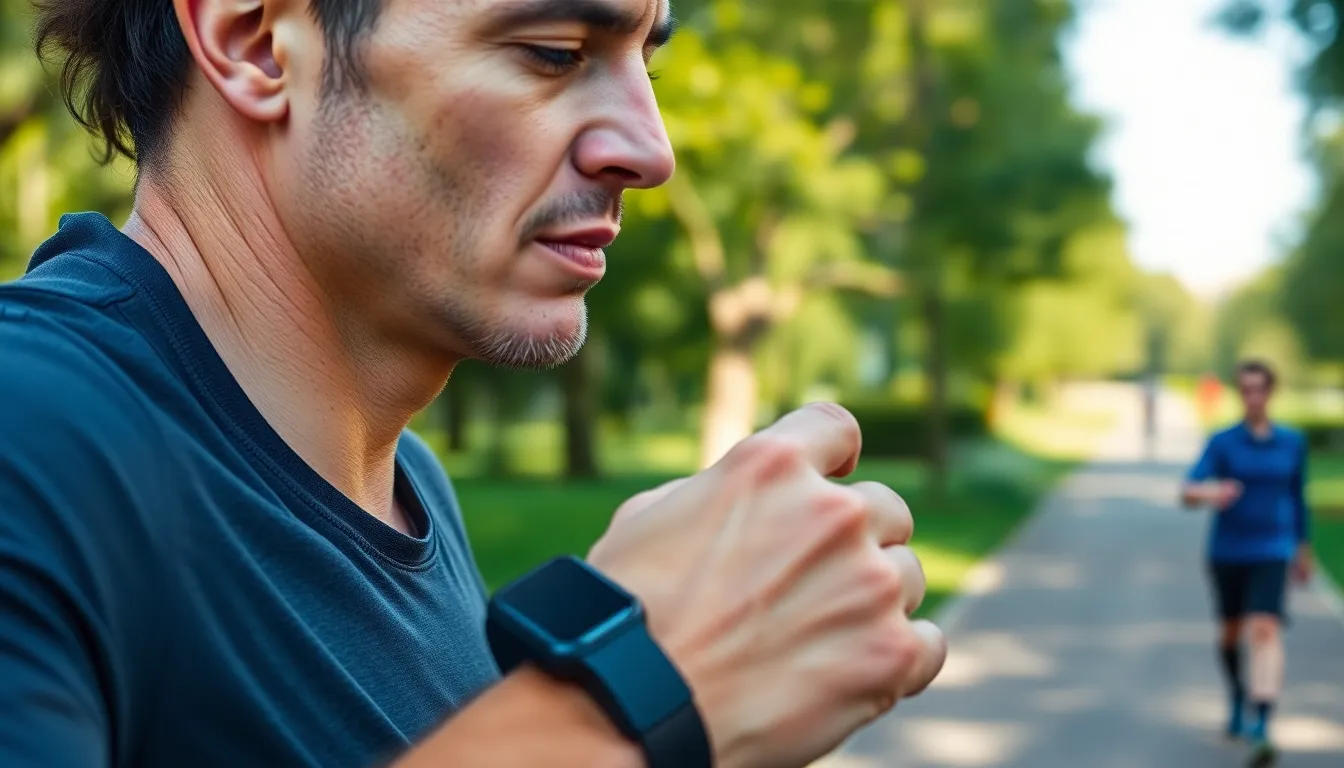Imagine strapping on a device that not only tracks your steps but also predicts when you’ll need a snack break. Welcome to the world of next-gen wearables, where technology meets everyday life in ways that are as exciting as they are practical. These gadgets are no longer just about counting calories or monitoring heart rates; they’re becoming personal assistants that fit snugly on your wrist or in your pocket.
From smartwatches that can read your mood to fitness trackers that can coach you through a workout, the future of wearables is here and it’s ready to impress. With each new innovation, these devices are transforming the way people interact with technology, making life easier, healthier, and a little more fun. Get ready to dive into the latest trends that are changing the game and discover how next-gen wearables can elevate your daily routine.
Table of Contents
ToggleOverview of Next-Gen Wearables
Next-generation wearables redefine personal technology experiences through enhanced features and capabilities. Smartwatches and fitness trackers integrate advanced sensors to monitor health metrics like sleep patterns, stress levels, and oxygen saturation. Privacy concerns influence design choices, prompting manufacturers to prioritize data protection while delivering effective functionality.
Augmented reality glasses, a key segment of next-gen wearables, provide immersive experiences that merge digital content with the real world. Developers focus on creating applications that enhance productivity, streamline workflows, and improve communication. Users benefit from hands-free navigation and information access while engaged in various activities.
Health-focused wearables, such as smart rings and biosensors, offer users insights into their overall wellness. These devices track biometric data continuously, allowing for proactive health management. Personalized feedback encourages users to adopt healthier habits and maintain better lifestyle choices.
Integration with smartphones and other smart devices enhances connectivity, enabling seamless communication between wearables and users’ digital ecosystems. Notifications, reminders, and real-time updates improve task management and connectivity without sacrificing user experience. Voice commands and gesture controls simplify interactions, making wearables more intuitive.
Sustainability considerations drive the development of eco-friendly materials and energy-efficient technologies. Brands increasingly emphasize reducing environmental impact while improving wearable durability. As innovations continue to emerge, next-gen wearables shape the future of technology, enriching everyday life through enhanced functionality and user engagement.
Key Features of Next-Gen Wearables

Next-gen wearables showcase cutting-edge technology, enhancing user experience with innovative features.
Advanced Sensors
Advanced sensors play a crucial role in next-gen wearables. These devices monitor vital health metrics, including heart rate, sleep patterns, and stress levels. Smart rings and biosensors provide continuous tracking for proactive health management. Enhanced accuracy in biometric data collection encourages users to optimize their fitness routines. Some wearables utilize electrocardiogram sensors to detect heart irregularities, promoting early intervention. Integration of thermometers helps monitor body temperature, providing insights during illness. Devices also track blood oxygen levels, assisting those with respiratory concerns. Overall, these sensors empower users to make informed health decisions.
Enhanced Connectivity
Enhanced connectivity transforms the functionality of next-gen wearables. These devices sync seamlessly with smartphones and other smart technologies. User notifications for calls, messages, and app alerts improve task management and response times. Wearables often support voice commands, offering hands-free interactions. Integration with smart home devices allows users to control their environments effortlessly. Data sharing between wearables and fitness apps promotes comprehensive health tracking. Companies prioritize security in connectivity features, addressing privacy concerns. As a result, users enjoy a cohesive tech ecosystem that simplifies everyday tasks.
Popular Types of Next-Gen Wearables
Next-gen wearables encompass various innovative devices transforming personal technology. Each type serves unique purposes, enhancing overall user experience.
Smartwatches
Smartwatches combine style with functionality, playing a central role in wearable technology. Equipped with advanced sensors, these devices monitor health metrics like heart rate, sleep patterns, and stress levels. Users benefit from features such as customizable watch faces, fitness coaching, and GPS navigation. Notifications for calls, texts, and calendar events enhance connectivity, simplifying daily routines. Compatibility with other devices creates a seamless tech ecosystem, allowing users to control smart home systems directly from their wrists.
Fitness Trackers
Fitness trackers focus on health and fitness, appealing to various lifestyles. Functions include tracking physical activity, calorie burn, and sleep quality, providing insights that motivate users to stay active. Many trackers feature heart rate monitors and step counters for precise data collection. Syncing with smartphones allows for easy access to fitness plans and performance stats. Some models even offer guided workouts and personalized coaching options, making it easier for users to achieve their fitness goals. These devices encourage healthier lifestyles through real-time feedback and progress monitoring.
Impact on Health and Fitness
Next-generation wearables significantly improve health and fitness management. Devices like smartwatches and fitness trackers aggregate valuable health data, enabling users to make informed decisions. Continuous monitoring of metrics such as heart rate, sleep quality, and stress levels empowers users with insights that can guide their lifestyle choices.
Equipped with advanced sensors, these wearables identify health trends and encourage proactive engagement. For instance, some models include electrocardiogram sensors that monitor heart rhythms, while others track oxygen saturation and body temperature, offering crucial information for individuals managing chronic conditions.
Smart rings and biosensors represent a growing market segment focused on health. These devices provide accurate biometric readings without the bulk of traditional wearables, promoting daily usage and consistent tracking. More importantly, integration with smartphones enhances overall user experience, allowing for seamless notifications and personalized feedback.
Wearable technology fosters a supportive community through fitness apps. Users can join challenges or share goals with friends, creating motivation and accountability in their health journeys. Incorporating social components transforms wearables from simple tools into interactive partners in wellness.
Sustainability remains a priority for manufacturers, driving the development of eco-friendly materials and energy-efficient designs. Addressing environmental concerns resonates with health-conscious consumers, further bridging the gap between technology and well-being.
The functionality of next-gen wearables extends beyond fitness metrics. They provide personalized coaching, adaptive workout plans, and progress tracking features that align with individual goals, fueling motivation and enhancing overall effectiveness. These advancements in wearable technology shape the future of health management and fitness engagement.
Future Trends in Next-Gen Wearables
Wearables increasingly feature advanced health monitoring capabilities. Smartwatches, for instance, now provide real-time data on heart health, hydration levels, and activity tracking. They track stress and sleep patterns through integrated sensors, allowing users to gain deeper insights into their well-being.
Augmented reality glasses continue to gain traction, offering innovative applications in both personal and professional contexts. These devices facilitate immersive experiences by overlaying digital elements onto the physical world. Enhanced productivity results from this fusion, allowing seamless integration into daily tasks.
AI-powered wearables offer personalized recommendations based on biometric data. Such devices analyze user behavior to suggest workouts or dietary changes tailored to individual needs. The ability to sync with smartphones enhances the user experience, facilitating easy access to essential information.
Sustainability remains a priority for manufacturers. Eco-friendly materials are being employed in device production to minimize environmental impact, while energy-efficient technologies extend battery life. This approach appeals to environmentally conscious consumers who value sustainable practices.
Fitness rings and biosensors promote a proactive approach to health. Continuous tracking empowers individuals to monitor progress, while community features in fitness apps foster motivation through shared goals. Users benefit from social engagement, enhancing their commitment to fitness pursuits.
Lastly, the trend toward enhanced connectivity drives the development of wearables that interface smoothly with home devices. Notifications for calls and messages are just the beginning, as voice commands become commonplace in everyday interactions. This integration creates a cohesive tech ecosystem, simplifying and enriching daily routines.
Next-gen wearables are revolutionizing the way individuals interact with technology and manage their health. With advanced features and seamless integration into daily life, these devices empower users to take control of their wellness and enhance productivity. As they evolve, wearables will continue to incorporate innovative technologies and sustainable practices, ensuring they meet the growing demands of consumers.
The future of wearable technology looks promising, with potential for even greater health monitoring capabilities and personalized experiences. As advancements unfold, users can expect wearables to become indispensable tools that not only promote healthier lifestyles but also enrich everyday living. Embracing these innovations can lead to a more connected and health-conscious society.



